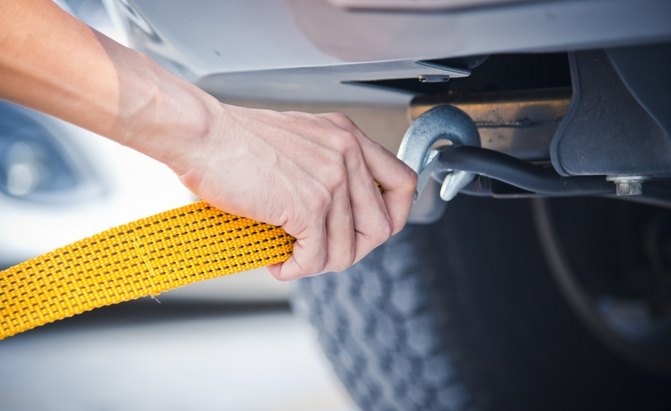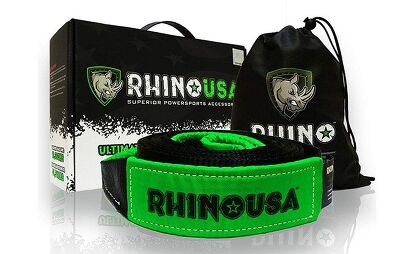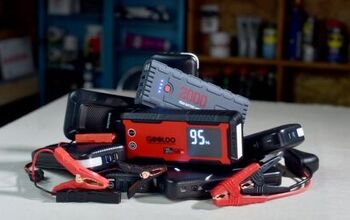The Best Tow and Recovery Straps

There’s a common misconception between tow straps and recovery straps, and often they are marketed as the same product. Although they look very similar, there are defining features to separate the two and their purposes. The largest difference between the two is that tow straps feature large metal hooks at each end, designed to hook onto towing points and shackles. Recovery straps meanwhile, do not have these hooks.
In this article, we’ll take a look at some of the most popular and best tow and recovery straps currently available, as well as explaining in detail the differences between the two. We’ll give advice on what to look for when shopping for either a tow or recovery strap, as well as when and how to use each product.
For more information on the best tow and recovery straps, refer to our table of contents.
Table of contents
- 1. Editor's Pick: Rhino USA Recovery Tow Strap
- 2. Smittybilt Recovery Strap
- 3. Long Range and Heavy Duty: Erickson 30' Recovery Strap with Sewn Loops
- 4. Grip Heavy Duty Tow Strap
- 5. HFS Polyester Tow Strap
- 6. USWAY GEAR Tow Strap
- 7. Sunferno Ultimate Tow Recovery Strap
- 8. GearAmerica Recovery Tow Strap
- 9. Rocket Straps Heavy Duty Tow Strap
- Tow Strap vs. Recovery Strap: What's the Difference?
- What to Look for When Shopping for a Tow or Recovery Strap
- How to Properly Use a Tow or Recovery Strap
- Recent Updates:
1. Editor's Pick: Rhino USA Recovery Tow Strap
Sporting a black and green finish, Rhino USA has a wide lineup of tow and recovery strap offerings. The company has a standard 3-inch by 8-feet tree saver tow strap at an affordable price, lab tested to a 31,518-pound break strength. It also offers 20- and 30-feet recovery tow straps with options to add either a hitch or shackles for added versatility and ease of use. Each strap also has triple reinforced loop ends to ensure peace of mind.
Rhino USA's straps feature exclusive polyester/silk webbing and come with a heavy duty drawstring carrying bag that is strong enough to hold over 10 lbs of vehicle accessories. Buyers also receive a lifetime warranty with their purchase.
Pros | Wide variety of applications, highly-rated break strength, includes carrying bag, lifetime warranty |
Cons | Price |
2. Smittybilt Recovery Strap
Smittybilt's recovery straps are available in a variety of sizes: 2 inch by 20 feet, 2 inch by 30 feet, 3 inch by 30 feet, 4 inch by 8 feet, and 4 inch by 20 feet. The 2-inch wide straps can pull up to 20,000 lbs, while the 3-inch wide strap supports up to 30,000 lbs. The 4-inch wide straps are the heaviest duty, with a 40,000-lb pull rating. These straps feature double-stitched webbing with a double hoop design for exceptional strength and durability.
Designed for towing vehicles, pulling equipment, and moving debris, Smittybilt's straps are weather resistant and engineered to high standards. The 4-inch wide versions are extra wide to protect tree trucks from damage.
Pros | Variety of sizes, heavy duty straps, double-stitched webbing, water resistant |
Cons | Price |
3. Long Range and Heavy Duty: Erickson 30' Recovery Strap with Sewn Loops
Erikson, a family-owned business from Ontario, Canada, makes some of the most best recovery straps in the industry, and the five-star ratings of their 30 foot, three-inch, 27,000-pound recovery strap hold up the family name. Sewn loops are our first choice if we're using a recovery strap regularly, and they're the choice of professionals who work in wet, messy conditions.
The webbing is a polyester-nylon blend for up to a 20% stretch and pull. All thread used is 415 series, which helps to meet or exceed advertised strength. For the sewn end loops, Erickson overlays a high-tenacity nylon for long life. It may not come with the big badges and fancy colors of the competition, but if you want a tool to do the job, Erikson is always a good choice.
Pros | Premium quality, high strength and great attention to details |
Cons | Expensive for a 3 x 30, won't stay white long |
4. Grip Heavy Duty Tow Strap
Grip's heavy duty tow strap measures 4 inches by 30 feet and has a working capacity of 6,666 lbs and breaking capacity of 20,000 lbs. Designed to tow or recover cars, ATVs, SUVs, boats, or light trucks, this product is an abrasion and weather resistant polyester web strap that will not rot or tear in extreme conditions. At each end are reinforced loop ends for maximum strength and durability.
Pros | Polyester, abrasion and weather resistant, reinforced loop ends |
Cons | 6,666-lb working capacity |
5. HFS Polyester Tow Strap
A more affordable tow strap is available from HFS, measuring 2 inch by 30 feet and constructed from high strength polyester. It has a 3,300-lb working load limit, a 5,000-lb recommended vehicle weight rating, and a 10,000-lb break strength capacity. The working load limit covers an industry standard safety rating that says if you are lifting objects vertically with this strap, you should only lift 1/3 of the strap's capacity.
As for the 5,000-lb recommended vehicle weight, this represents the safety rating to accommodate for jerking, a stuck vehicle, angle of tow, friction, and more. This means a vehicle that weighs 5,000 lbs is actually putting 9,000 lbs of stress on the strap during certain situations. The webbing's actual rated capacity is 10,000 lbs, which is the weight the strap has been tested to withstand.
This product from HFS is equipped with quick snap-on forged safety hooks on both sides, featuring retaining clips so they stay attached while towing. The hooks are zinc coated, offering three times more corrosion resistance.
Pros | Price, high strength polyester, zinc-coated safety hooks, retaining clips |
Cons | 3,300-lb working load limit |
6. USWAY GEAR Tow Strap
A highly-rated product on Amazon comes from USWAY GEAR. This is a 3-inch wide tow strap that is available in either 20 feet or 30 feet of length. Both versions have a 10,000-lb working load and 30,000-lb rated capacity, while staying lightweight and compact. This strap is made of carefully woven polyester and features reinforced stitching and loops for added durability. It is also moisture and weather resistant, waterproof, tough yet flexible, and can be washed to improve lifespan.
The tow strap comes with a lifetime warranty and can be used with pickup trucks, SUVs, ATVs, vans, boats, off-road cars, emergencies, water sports, and more.
Pros | Price, polyester, reinforced stitching and loops, moisture and weather resistant, waterproof, includes carrying bag, lifetime warranty |
Cons | Shackles sold separately |
7. Sunferno Ultimate Tow Recovery Strap
Another heavy duty option comes from Sunferno, with a 3-inch wide by 20-foot long tow recovery strap (also available with 8-foot length). This strap claims to have 7 percent maximum stretch with 35,000-lb break strength. This option features reinforced eye loops, a protective sleeve, and a high-visibility bright green finish. Use it to safely remove fallen trees, stumps, or bushes if necessary and it’s also water resistant, so you can easily clean it after it’s used.
Each strap includes a protective sleeve, a bonus wrap tie, and a carrying bag.
Pros | 35,000-lb break strength, single-ply webbing, reinforced loops, protective sleeve, 7-percent maximum stretch, includes carrying bag, good customer service |
Cons | Some owners have experienced durability issues |
8. GearAmerica Recovery Tow Strap
Available in a variety of sizes is GearAmerica's heavy duty strap. Buyers can choose from 3-inch wide by 8-feet long, 3-inch wide by 20-feet long, 4-inch wide by 10-feet long, and 4-inch wide by 30-feet long. The company also offers bundles of different sizes, or certain straps in pairs. Rugged and weather resistant, GearAmerica's strap features protective sleeves to prevent wear and tear, military grade webbing that withstands extreme loads and temperatures (-40°F to 215°F), as well as triple-reinforced loops to protect against abrasion.
The 3-inch wide by 8-foot long version of this strap has been lab tested up to 35,000 lbs, while the 20-foot long version is rated at 35,054 lbs. The 4-inch wide by 30-feet long strap has been tested to 41,455 lbs.
Constructed from high tensile 100-percent polyester, this strap is mildew, moisture, and UV resistant. Each strap comes with a convenient velcro tie and storage bag.
This product has been lab tested to support up to 35,000 lbs and comes with a lifetime guarantee. More importantly, GearAmerica donates 10 percent of its profits to the St. Jude Children's Research Hospital.
Pros | Variety of sizes, weather resistant, protective sleeves, military grade webbing, high tensile polyester, includes velcro tie and storage bag, donation to St. Jude Children's Research Hospital |
Cons | Not actually made in America |
9. Rocket Straps Heavy Duty Tow Strap
Made with the highest grade 100% polyester material, this heavy duty tow strap from Rocket Straps is UV and weather resistant, while remaining extremely flexible. Measuring 3" by 30', this strap has a rated capacity of 30,000 lbs (10,000 lbs working load) and features heavy duty reinforced looped ends to take the strain off anchor points. Protective sleeves can be found on each end of the tow strap, providing additional durability and protection for the strap.
Designed to be used in all weather conditions, Rocket Straps includes a drawstring carrying bag with its tow strap and backs its product with a lifetime warranty.
Pros | Rated capacity of 30,000 lbs, 100% polyester material, UV and weather resistant, protective sleeves, reinforced looped ends, drawstring carrying bag, lifetime warranty |
Cons | Some users report the ends fray easily |
Tow Strap vs. Recovery Strap: What's the Difference?
As we mentioned before, knowing the differences between a tow strap and a recovery strap is really important so you purchase the right tool for the job. As their name suggests, tow straps are designed specifically for towing and shouldn't be used for recovery. These straps latch onto the tow hooks and then shackles or d-rings to pull another vehicle. A main reason why tow straps shouldn't be used for recovery is that they don't stretch, which means a higher chance that they'll break or come undone, causing the attached hook to go flying. This can be especially dangerous in some situations and have even caused death.
Recovery straps are different in that their material provide some elasticity so that they stretch. You can easily identify recovery straps as they have loops at each end, which are attached to recovery or frame points often found under trucks or on truck bumpers. Their stretching property is more important however, as these straps will initially stretch to their capacity, before pulling the vehicle as it attempts to go back to its original condition. More importantly, these straps do not have any hooks or metal pieces attached to them, making them safe to use if they accidentally come undone.
In other words, recovery straps are best used to get pull out a stuck vehicle, while tow straps should be used to tow a freely-moving vehicle.
What to Look for When Shopping for a Tow or Recovery Strap
As we mentioned before, the most important factor to look for when shopping for a recovery strap is its elasticity. You will want to make sure the recovery strap is able to stretch without breaking. Now, regardless of whether you're shopping for a tow or recovery strap, you'll want to make sure its length and width will accommodate your needs.
Once you've narrowed down your product choices based on the size of the strap, pay close attention to the rating that the company advertises. Oftentimes this will be the break strength capacity, which is not what it's really capable of towing. If possible, find out the recommended vehicle rating for the strap, which is more indicative of what it is capable of towing.
If you're shopping for a tow strap, make sure the hooks at each end are made of high quality material. The last thing you want is your hook snapping or breaking off while trying to tow a vehicle.
Durability is also a factor to look into, as you want a product that's weather resistant and waterproof so it lasts as long as possible. If you plan on using your tow or recovery strap often, make sure it's durable and built to last, especially if you're going off-roading.
How to Properly Use a Tow or Recovery Strap
It may seem straightforward on how to use a tow or recovery strap, but doing it incorrectly could cause damage to your vehicle, or even worse, to a human being. Your specific situation may call for different steps, but here are some general guidelines to follow for using your tow or recovery strap.
- Make sure the tow strap is capable of towing your load: We've stressed before, determine the actual payload weight your tow strap is rated for before attaching it to a vehicle. Thoroughly inspect the strap to make sure there aren't any tears that could weaken it.
- Locate the tow hook on the vehicle you are about to tow: You will generally find tow hooks on the front of a vehicle, while the rear of a vehicle may have a receiver that a tow strap can connect to. These are generally the only areas you want to hook up a vehicle, as anywhere else could possibly damage the car. If you cannot locate a tow hook anywhere on the vehicle, connect your strap to the vehicle's frame. But only do that if you have no other options.
- Connect your tow strap: Start by connecting the tow hook to one end of the strap. If you're using a strap with a loop at the end, you should thread the loop through the hook. The rest of the strap should then be pulled through the loop. Double check to make sure the hook's open end is facing downward so it can't accidentally become unhooked.
- Move your car: For the car that's doing the towing, park it close to the vehicle that's being towed. Attach the other end of the strap to it using the same steps as above.
- Put the car being towed into neutral: Once the car being towed is in the neutral position, make sure there's someone in that vehicle. Then slowly drive the other vehicle and be especially careful if there's a lot of slack in your strap. Try to avoid any sudden movements as they can damage the vehicles, hooks, and straps. If you're experiencing a lot of resistance, double check that everything has been properly hooked up and that you're using the right strap for the situation.
- Use caution when coming to a stop: You'll want to gradually slow down in the vehicle doing the towing, and make sure the person inside the vehicle that is being towed is ready to apply the brakes if necessary. If you're towing a vehicle downhill, you will especially want the driver inside the vehicle being towed to pay close attention.
- Unhook everything once you've arrived at your destination: Once you've unhooked and taken off your tow or recovery strap, make sure any other accessories such as shackles are also removed. Store the strap in a safe place so it's ready to be used next time.
Recent Updates:
June 21, 2022: Removed promoted product recommendation.
December 23, 2021: Added additional link for Erickson strap.
December 21, 2021: Replaced Jacko with Miolle promoted product.
October 29, 2021: Replaced Neiko strap with Erickson 30' Recovery Strap.
June 21, 2021: Updated with a promoted product recommendation.
May 17, 2021: Updated the listing for Sunferno's Ultimate Tow Recovery Strap with a new image and product link.
April 6, 2021: Updated the description for the USWAY GEAR tow strap to reflect the company's updated lifetime warranty on its product.
March 25, 2021: Updated the product description for Sunferno's Ultimate Tow Recovery Strap for accuracy. Removed the Presa Heavy Duty Tow Strap with Hooks recommendation due to availability. Added the JACO TowPro Recovery Tow Strap to our list of recommendations. Updated the description and link for GearAmerica's recommendation.
We are committed to finding, researching, and recommending the best products. We earn commissions from purchases you make using the retail links in our product reviews. Learn more about how this works.
Photo Credit: PATIWIT HONGSANG / Shutterstock.com

Jason Siu began his career in automotive journalism in 2003 with Modified Magazine, a property previously held by VerticalScope. As the West Coast Editor, he played a pivotal role while also extending his expertise to Modified Luxury & Exotics and Modified Mustangs. Beyond his editorial work, Jason authored two notable Cartech books. His tenure at AutoGuide.com saw him immersed in the daily news cycle, yet his passion for hands-on evaluation led him to focus on testing and product reviews, offering well-rounded recommendations to AutoGuide readers. Currently, as the Content Director for VerticalScope, Jason spearheads the content strategy for an array of online publications, a role that has him at the helm of ensuring quality and consistency across the board.
More by Jason Siu










































Comments
Join the conversation